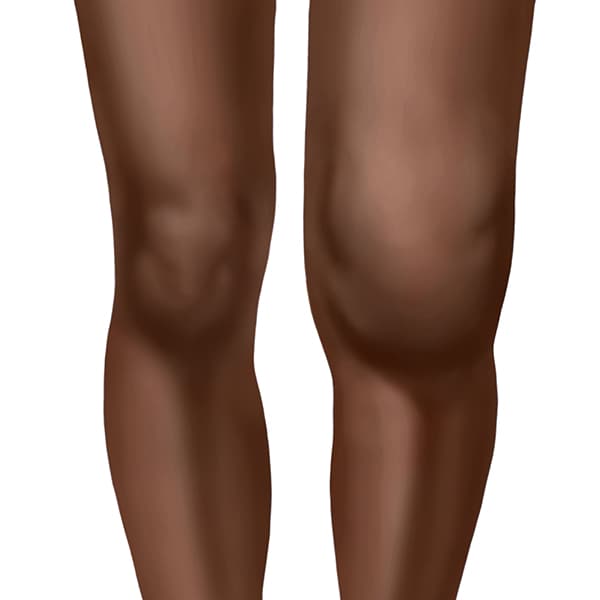What to know
- Lyme arthritis occurs when Lyme disease bacteria enter joint tissue and cause inflammation.
- People who do not receive prompt treatment for Lyme arthritis are at risk of developing permanent joint damage.

Symptoms
The main feature of Lyme arthritis is obvious swelling of one or a few joints. While the knees are affected most often, other large joints such as the shoulder, ankle, elbow, jaw, wrist, and hip can also be involved. The joint may feel warm to the touch or cause pain during movement. Joint swelling can come and go or move between joints, and it may be difficult to detect in the shoulder, hip, or jaw. Lyme arthritis typically develops within one to a few months after infection.

Treatment
An initial episode of Lyme arthritis should be treated with a 4-week course of oral antibiotics. Patients with persistent joint inflammation and pain after the first course of antibiotics may require a second course (see tables below). In some cases, joint swelling and pain can persist or recur after two courses of antibiotics. The cause of persistent arthritis is unknown but is thought to be driven by immunologic factors. Additional antibiotics have not been shown to improve these symptoms, and patient referral to a rheumatologist should be considered.
If left untreated, permanent damage to the joint can occur. Lyme arthritis accounts for approximately one out of every four Lyme disease cases reported to CDC. Because of reporting practices, this statistic may overstate the frequency of arthritis among patients seen in routine clinical practice.
Key points for healthcare providers
- Antibody-based Lyme disease tests have excellent sensitivity in patients with Lyme arthritis. PCR can be used as an adjunctive diagnostic test to identify DNA in synovial fluid but should not be the first lab test used.
- Lyme arthritis can be mistaken for septic arthritis, especially in children. Whereas septic arthritis may require surgical intervention, Lyme arthritis generally does not.
- Talk to patients about tick bite prevention.
Antibiotic treatment of Lyme arthritis
These regimens may need to be adjusted depending on a person’s age, medical history, underlying health conditions, pregnancy status, or allergies. Consult an infectious disease specialist regarding individual patient treatment decisions.
| Age Category | Drug | Dosage | Maximum | Duration (days) | References |
|---|---|---|---|---|---|
| Adults | Doxycycline | 100 mg, twice per day orally | N/A | 28 | 1 |
| Amoxicillin | 500 mg, three times per day orally | N/A | 28 | 1 | |
| Cefuroxime | 500 mg, twice per day orally | N/A | 28 | 1 | |
| Children ≥8 years old |
Doxycycline | 4.4 mg/kg per day orally, divided into 2 doses | 100 mg per dose | 28 | 1,4 |
| Amoxicillin | 50 mg/kg per day orally, divided into 3 doses | 500 mg per dose | 28 | 1,4 | |
| Cefuroxime | 30 mg/kg per day orally, divided into 2 doses | 500 mg per dose | 28 | 4 | |
| Children <8 years old | Amoxicillin | 50 mg/kg per day orally, divided into 3 doses | 500 mg per dose | 28 | 4 |
| Cefuroxime | 30 mg/kg per day orally, divided into 2 doses | 500 mg per dose | 28 | 4 |
* For patients with an initial episode of Lyme arthritis, a full course of oral antibiotics are recommended. For patients with improving but persistent symptoms after an initial course of oral antibiotics, a second course of the same oral antibiotic or observation alone can be considered.
| Age Category | Drug | Dosage | Maximum | Duration (days) | References |
|---|---|---|---|---|---|
| Adults | Ceftriaxone* | 2 grams intravenously, once a day | N/A | 14 – 28 | 2,3 |
| Children | Ceftriaxone* | 50-75 mg/kg intravenously, once a day | 2 grams per day | 14 – 28 | 2,3 |
†Intravenous ceftriaxone is the preferred regimen for the second course of antibiotics for patients without any response after the initial course of antibiotics.
Treatment references
- Daikh, B. E., Emerson, F. E., Smith, R. P., Lucas, F. L., & McCarthy, C. A. (2013). Lyme arthritis: a comparison of presentation, synovial fluid analysis, and treatment course in children and adults. Arthritis Care Res (Hoboken). 2013;65(12):1986-1990.
- Dattwyler RJ, Halperin JJ, Pass H, Luft BJ. Ceftriaxone as effective therapy in refractory Lyme disease. J Infect Dis. 1987;155(6):1322-1325.
- Dattwyler RJ, Wormser GP, Rush TJ, et al. A comparison of two treatment regimens of ceftriaxone in late Lyme disease. Wien Klin Wochenschr. 2005;117(11-12):393-397.
- Tory HO, Zurakowski D, Sundel RP. Outcomes of children treated for Lyme arthritis: results of a large pediatric cohort. J Rheumatol. 2010;37(5):1049-1055.
